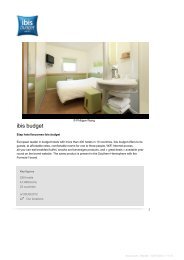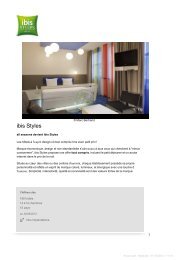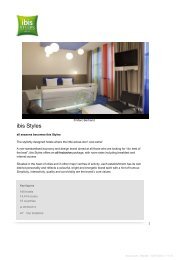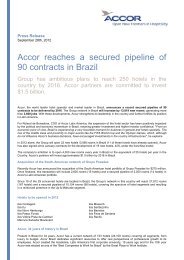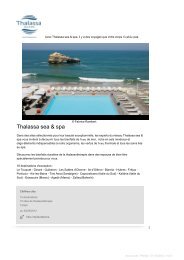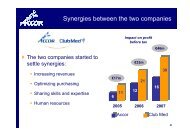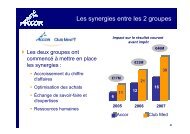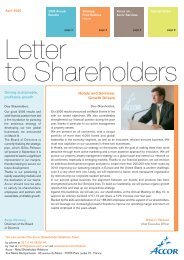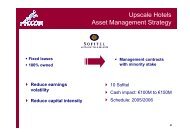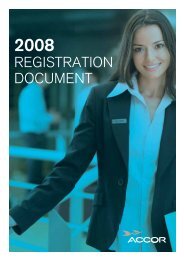SECTION 1 -
SECTION 1 -
SECTION 1 -
You also want an ePaper? Increase the reach of your titles
YUMPU automatically turns print PDFs into web optimized ePapers that Google loves.
173<br />
New Services: Historical Combined Financial Statements and Notes<br />
December, 31, 2009<br />
1) A tax assessed on the rental value of real estate ("CFE"). Similar to the "taxe professionnelle", it fulfills the criteria for<br />
recognition as an operating expense.<br />
2) A tax assessed on the value added by the business ("CVAE"), which has some of the characteristics of a tax on income,<br />
as defined in IAS 12.<br />
In a press release dated January 14, 2010, France’s National Accounting Board, the Conseil National de la Comptabilité, stated<br />
that each business should exercise its own judgment to determine the accounting classification of the CVAE.<br />
In March 2006 and March 2009, the IFRIC stated that income taxes are defined as taxes that are based on taxable profit, and that<br />
the term ‘taxable profit’ implies a notion of a net rather than a gross amount. Additionally, because taxable profit is not the same<br />
as accounting profit, taxes do not need to be based on a figure that is exactly accounting profit to be within the scope of IAS 12.<br />
Value added used to calculate the CVAE is a net amount, not a gross amount. Moreover, experience shows that certain foreign<br />
taxes assessed on the basis of profit indicators other than profit before tax are generally qualified as income taxes under IAS 12.<br />
Examples exclude Germany’s Gewerbesteuer tax and Italy’s IRAP tax. In the interests of consistency, New Services has therefore<br />
decided to consider that the CVAE falls within the scope of IAS 12. The analyses performed by the Group nevertheless showed<br />
that the deferred tax liability to be recognized at December 31, 2009 was not material. Consequently, no deferred tax liability<br />
was recorded at that date.<br />
N. Share‐based payments<br />
N.1 STOCK OPTION PLANS<br />
In accordance with the transitional provisions of IFRS 1 – First‐time Adoption of International Financial Reporting Standards,<br />
compensation cost is recognized only for grants of shares, stock options or other equity instruments that were made after<br />
November 7, 2002 and had not yet vested at January 1, 2005. No compensation cost is recognized for plans dating back prior to<br />
November 7, 2002.<br />
IFRS 2 applies to twelve stock option plans set up between 2003 and December 2009. Eleven of these plans do not have any<br />
specific vesting conditions except for the requirement for grantees to continue to be employed by the Group at the starting date<br />
of the exercise period. One plan is a performance option plan with vesting conditions other than market conditions. As for the<br />
other plans, grantees must still be employed by the Group at the starting date of the exercise period.<br />
The service cost representing consideration for the stock options is recognized as an expense over the vesting period by adjusting<br />
equity. The expense recognized in each period corresponds to the fair value of the services received at the grant date, as<br />
determined using the Black & Scholes option‐pricing model. The grant date is defined as the date when the plan's terms and<br />
conditions are communicated to Group employees and corresponds to the date on which the Board of Directors approved these<br />
plans. Under IFRS 2, vesting conditions other than market conditions are not taken into account when estimating the fair value of<br />
the services received. However, they are taken into account by adjusting the number of equity instruments included in the<br />
measurement of the transaction amount, so that, ultimately, the amount recognized for services received as consideration for<br />
the equity instruments granted is based on the number of equity instruments that eventually vest.<br />
When the options are exercised, the cash settlement is recorded in cash and cash equivalents and in equity. The amount<br />
recognized in equity is allocated between "Share capital" and "Additional paid‐in capital".<br />
N.2 EMPLOYEE STOCK OWNERSHIP PLAN<br />
IFRS 2 also applies to employee benefits granted through the employee stock ownership plans to the extent that shares are<br />
purchased at a discount by participating employees. Accordingly, when rights under the plan are exercisable at a price that is less<br />
than the fair value of the shares at the grant date, an expense is recognized immediately or over the vesting period, as<br />
appropriate.<br />
The Group's employee stock ownership plans enable employees to invest in stock at a discounted price. The share purchase price<br />
before the discount is based on the average of the prices quoted for Accor stock over the twenty trading days preceding the<br />
grant date. The shares are subject to a five‐year lock‐up.




